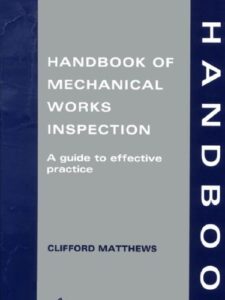Handbook of Mechanical Works Inspection A guide to effective practice 1st Edition
Handbook of Mechanical Works Inspection A guide to effective practice 1st Edition
Handbook of Mechanical Works Inspection will not make you a technical expert on individual pieces of plant or help you to write quality assurance manuals. It is a practical ‘how to do it’ guide to works inspection for the non-specialist. It will help you plan and carry out successful inspections of common mechanical equipment; technical information you need to know is provided and the methodology of inspection is explained. If you follow the techniques described and start to apply them to your works inspections then this can help you do things the right way.
In a large engineering construction project, a wide range of plant items have to be inspected before acceptance. As professional technicians or engineers we are likely, at some point, to be asked to inspect this equipment in the manufacturer’s works. Consultants, end-users, contractors and manufacturers all have their part to play. This is fine. The problem is that it is very difficult for those of us who inspect and accept such equipment to have detailed technical knowledge relating to the wide scope of equipment we are likely to see. That having been said,
what we must aim for is works inspection which is effective; that does not just ‘do the job’.
You can also Read Engineers Guide to Rotating Equipment The Pocket Reference
Handbook of Mechanical Works Inspection Content
- Foreword
![Handbook of Mechanical Works Inspection A guide to effective practice 1st Edition]()
- Preface
- Acknowledgements
- How to use this book
- Objectives and tactics
- Specifications, standards, and plans
- Materials of construction
- Welding and NDT
- Boilers and pressure vessels
- Gas turbines
- Steam turbines
- Diesel engines
- Power transmission
- Fluid systems
- Cranes
- Linings
- Painting
- Inspection reports
- Appendix
- Index
One undeniable change has been an increase in the competitive nature of the engineering inspection business. The days of large volume ‘cost plus’ inspection contracts have gone and will not return. The resulting downward pressure on fees has caused inspection companies to react in different ways. Some have specialized, taking care to match carefully their inspectors’ skills to the main areas of demand, but others have preferred to cut their overheads and fees in the belief that they have no alternative.


Comments are closed.